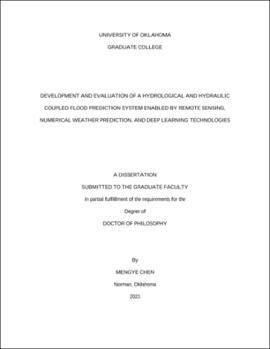| dc.contributor.advisor | Hong, Yang | |
| dc.contributor.author | Chen, Mengye | |
| dc.date.accessioned | 2021-05-17T20:33:24Z | |
| dc.date.available | 2021-05-17T20:33:24Z | |
| dc.date.issued | 2021-05-14 | |
| dc.identifier.uri | https://hdl.handle.net/11244/329603 | |
| dc.description.abstract | Floods triggered by extreme precipitation are the most frequently occurring and disastrous natural hazards in the world. However, it is still challenging to provide accurate and flood mapping, flood damage estimation, and flood forecast. The purpose of this dissertation is to develop a hydrological and hydraulic coupled flood prediction system, inundation MApping and Prediction (iMAP), which can provide comprehensive flood simulation and prediction including channel flow rate, flood return period, flood extent, surface flow speed, and direction, as well as inundation depth and soil moisture. Up until now, the Coupled Routing and Excess STorage (CREST) model family has been well documented and established both in research and in real-world operation. As a new member of the CREST family, the work in this dissertation carries on the features of CREST model, as being robust, efficient, automated, and globally applicable. Moreover, the study also evaluates multiple remote sensing and precipitation prediction technologies during the historical event Hurricane Harvey. The results of the studies demonstrate that the CREST-iMAP system has the ability to provide comparable Harvey flood simulation as multiple real-time and operational flood monitoring systems in the world, and the best result comes from using Multi-Radar Multi Sensor (MRMS) Quantitative Precipitation Estimates (QPE), which the combination considers as the best practice in the Contiguous United States (USA). The results also indicate that the uncalibrated precipitation estimates perform better during extreme events like Hurricane Harvey, and precipitation forecasts still need more improvement to provide more information on flood prediction. However, the Numerical Weather Prediction (NWP) product can provide a preliminary forecast of the maximum flood extent, while the deep learning method could potentially improve the displacement issues from NWP forecasts. | en_US |
| dc.language | en_US | en_US |
| dc.rights | Attribution-ShareAlike 4.0 International | * |
| dc.rights.uri | https://creativecommons.org/licenses/by-sa/4.0/ | * |
| dc.subject | Flood simulation | en_US |
| dc.subject | Remote sensing | en_US |
| dc.subject | H&H coupling | en_US |
| dc.subject | Hydrological model | en_US |
| dc.title | Development and evaluation of a hydrological and hydraulic coupled flood prediction system enabled by remote sensing, numerical weather prediction, and deep learning technologies | en_US |
| dc.contributor.committeeMember | Xue, Ming | |
| dc.contributor.committeeMember | Gourley, Jonathan | |
| dc.contributor.committeeMember | Muraleetharan, Kanthasamy | |
| dc.contributor.committeeMember | Kolar, Randall | |
| dc.date.manuscript | 2021-05-12 | |
| dc.thesis.degree | Ph.D. | en_US |
| ou.group | Gallogly College of Engineering::School of Civil Engineering and Environmental Science | en_US |
| shareok.orcid | 0000-0003-2135-1670 | en_US |
| shareok.nativefileaccess | restricted | en_US |

